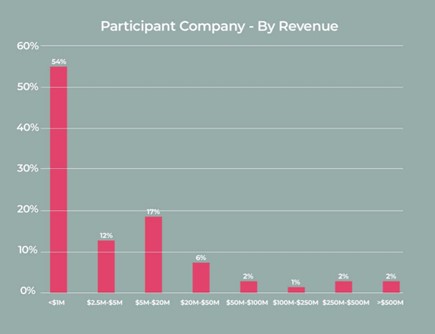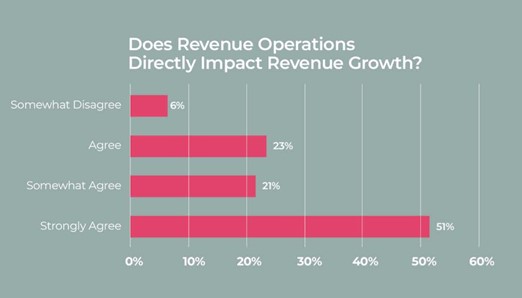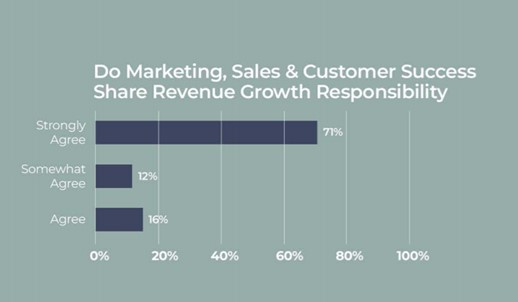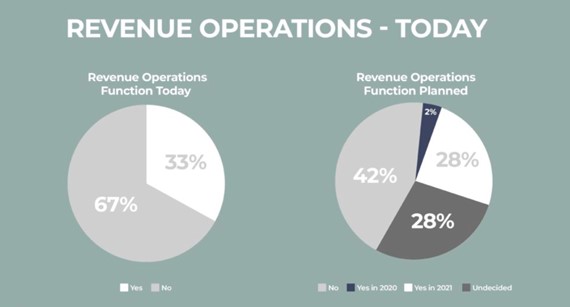As the business world becomes more saturated and the level of competition increases, business leaders have innovated how they run their business and the service they give to customers.
As a result, organizations have moved from a siloed mentality to one that integrates marketing, sales, and customer success operations and ensures an alignment of communication and objectives and greater access to data and data flows between customer-centric departments of an organization. This particular refocus on the organizational structure has focused on what makes a business "healthy" and keeps it standing: revenue. From this mindset, we get RevOps.
The Covid-19 pandemic has ignited many challenges for businesses worldwide, and the way that these align and communicate internally is under pressure to keep them alive.
The question is: how will RevOps fair in the future?
Revenue Operations Today
A sound RevOps strategy is vital for business and revenue growth. Most organizations that have successfully adopted a revenue operations approach would agree that it is an integral component of their success.
GoNimbly, RevOps Squared, and HubSpot conducted a study with their clients between September and October 202 to understand the purpose and the maturity of these organizations' revenue operations. For this article's purposes, the results from this research will help determine the current state of RevOps.
For some context, participant companies, on average, had a yearly revenue of less than $1 million.

(Source: Go Nimbly)
Correlation between revenue operations and revenue growth
51% of companies strongly agreed that a revenue operations approach had impacted its revenue growth.

(Source: Go Nimbly)
Alignment of customer-facing departments
71% of participants strongly agreed that Marketing, Sales, and Customer Success share a mutual responsibility for revenue growth.

(Source: Go Nimbly)
Planning your revenue operations strategy
As the pandemic continues to influence the current state of affairs worldwide, it has become essential for organizations to develop strategies to continue their business operations, gain new customers, and generate more revenue.
Of the businesses surveyed by GoNimbly, RevOps Squared, and HubSpot between September and October of 2020, 28% of companies had preplanned their revenue operations processes for 2021.
Compared to the 42% of businesses that had preplanned their RevOps strategy for 2020, the difference is stark.

(Source: GoNimbly)
Revenue Operations moving forward
For 2021 and beyond, revenue operations will likely continue to play a central role in business operations.
According to a 2020 LeanData report on B2B revenue trends, B2B companies that align their revenue-generating strategies across the various departments involved in revenue growth are 12 to 15 times more likely than their competition and are 34% more profitable.
For this reason, it is expected that RevOps will continue to play a decisive role in how organizations structure their processes in the years to come.
The Covid-19 pandemic and its effects on RevOps
As social distancing measures transformed the way organizations interacted internally and with their customers, the digital transformation in sales paved the way to the RevOps engine.
While there is no precise definition of the revenue engine, this term is used in reference to the alignment of customer-centric functions (including marketing, sales, and customer success) within a company and how much of these functions contribute to a company's desired revenue growth.
The pandemic has spearheaded many changes in the way teams interact with one another and with their customers. For this reason, the future of RevOps will be heavily influenced by this.
Unifying a definition for revenue operations
Currently, there is no standardized definition for “revenue operations” that is used across diverse organizations, industries, and locations.
Some consider RevOps as a means for achieving revenue recognition. Others see it as the act of merging marketing, sales, and customer success into a single operations department whose sole focus is to improve the customer’s experience, improve customer satisfaction, and influence brand loyalty. Still, others consider revenue operations as a means to focus on real-time data and analytics to make better decisions to maximize business growth.
As is expected, these variety of definitions can cause confusion among businesses interested in unifying their customer-facing departments.
As the number of companies across the board that choose to adopt a RevOps organizational structure increases, the need and interest in establishing a consistent definition will too.
An increase in RevOps educational resources
To bring everyone on board with a standardized definition and process for “how-to” revenue operations, we will likely see an increase in the number of courses, trainings, and certifications that aim to educate leadership, marketing, sales, and customer success professionals.
Remote selling
Remote selling and the need to stay (virtually) connected has led to an increased demand for tools that facilitate this process while driving efficiency and accountability for teams across the customer journey.
Tools and Platforms that can increase transparency
Revenue operations are all about aligning common objectives across the different functions of an organization.
To help with this endeavor, businesses have gravitated toward using tools and platforms that can increase the level of transparency and the access of data necessary for marketing, sales, customer success, and other teams need to help drive revenue.
Companies prefer tools that can be implemented for a diversity of functions and can also easily integrate to other tools and automate data workflows.
"Optimizing" the customer's experience
Aside from increasing revenue growth, enhancing the customer experience is a central focus of revenue operations.
As consumers become more educated about their options and aware of what they want and need, RevOps teams will need to provide more excellent value and return on investment (ROI) for their customers. Businesses will need to continue to deliver high levels of customer satisfaction.
An increase in automation
Successful RevOps teams typically adopt a system of automated processes to achieve greater efficiency and predictability of their results.
For this reason, there is a tendency for marketing, sales, and customer success teams to implement more strategic and proactive solutions to provide the best service to their customers while maintaining their internal alignment.
While organizations will continue to optimize their business processes, they will also gravitate toward improving their business objectives according to their industry's changing needs.
Greater emphasis on data-driven decisions
RevOps strategies that focus on scaling revenue growth will require accurate, real-time data that is made available across teams.
The best predictor of success is data, so leveraging any analytics insights to determine which decisions, focus, and investments are required for predictable success are in order in 2021 and beyond.
RevOps for a competitive edge
Companies that heavily invest in revenue operations can often gain a competitive advantage from others within their industry.
As business leaders continue to prepare for the unexpected twists and turn the current pandemic brings, RevOps professionals will need to make sound decisions based on data and have the flexibility to change their strategies to pivot and adapt effortlessly.




